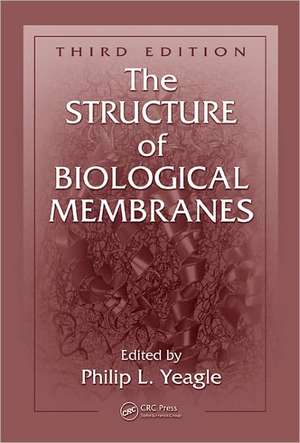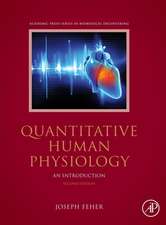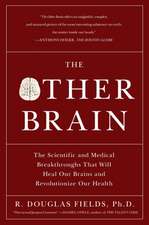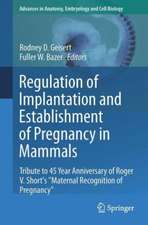The Structure of Biological Membranes
Editat de Philip L. Yeagleen Limba Engleză Hardback – 18 iul 2011
The first part of the book focuses on the fundamentals of lipid bilayers and membrane proteins. Three introductory chapters supply those new to the field with the tools and conceptual framework with which to approach the state-of-the-art chapters that follow. The second part of the book presents in-depth analyses of focused subjects within the study of membranes, covering topics that include:
- Phase behavior of lipid bilayers
- Lipid bilayers as an isolated structure
- Cholesterol’s role in cell biology
- Lateral organization of membranes
- The role of membrane lipids in initial membrane protein folding
- Membrane protein synthesis and assembly of oligomeric membrane proteins
- Membrane protein stability with relationships to function and protein turnover
- Membrane protein function using a transport protein
- Interactions between membrane proteins and membrane lipids
What’s New in This Edition:
- Three accessible chapters introduce students to the field of biological membranes
- Completely revised and updated chapters present current topics in membrane research
Preț: 1559.82 lei
Preț vechi: 1902.21 lei
-18% Nou
Puncte Express: 2340
Preț estimativ în valută:
298.51€ • 324.13$ • 250.75£
298.51€ • 324.13$ • 250.75£
Carte tipărită la comandă
Livrare economică 22 aprilie-06 mai
Preluare comenzi: 021 569.72.76
Specificații
ISBN-13: 9781439809570
ISBN-10: 1439809577
Pagini: 398
Ilustrații: 115 b/w images, 25 tables, 1 halftone and 52 equations
Dimensiuni: 178 x 254 x 28 mm
Greutate: 0.88 kg
Ediția:Revizuită
Editura: CRC Press
Colecția CRC Press
ISBN-10: 1439809577
Pagini: 398
Ilustrații: 115 b/w images, 25 tables, 1 halftone and 52 equations
Dimensiuni: 178 x 254 x 28 mm
Greutate: 0.88 kg
Ediția:Revizuită
Editura: CRC Press
Colecția CRC Press
Public țintă
Structural biologists, biophysicists, cell biologists, biochemists, and researchers in the pharmaceutical industry.Cuprins
Introduction to Lipid Bilayers. Membrane Proteins. Introduction to Lipid–Protein Interactions in Biological Membranes. The Mesomorphic Phase Behavior of Lipid Bilayers. IR Spectroscopy of Lipid Chains: Theoretical Background and Applications to Phase Transitions, Membranes, Cells, and Tissues. The Roles of Cholesterol in the Biology of Cells. Functional Consequences of the Lateral Organization of Biological Membranes. Mechanisms by Which Pathogens Hijack and Utilize Membrane Domains to Mediate Cytotoxicity. Lipid-Assisted Membrane Protein Folding and Topogenesis. Membrane Protein Biogenesis and Assembly at the Endoplasmic Reticulum Membrane. Thermal Denaturation of Membrane Proteins. Mass Action Kinetic Analysis of Multidrug Resistance Transporters Expressed in Confluent Cell Monolayers. How to Understand Lipid–Protein Interactions in Biological Membranes. Biogenesis of Lipids and Proteins within Mitochondrial Membranes. Index.
Notă biografică
Philip L. Yeagle is dean of the Faculty of Arts and Sciences and chief academic research officer at Rutgers University, Newark, New Jersey. He obtained his PhD at Duke University in 1974. As a postdoctoral fellow at the University of Virginia, he started his studies of membrane structure and dynamics, supported by an NIH postdoctoral fellowship. There he was one of the first investigators to discover and exploit the opportunities for 31P NMR studies of model and biological membranes.
He began his faculty career in the School of Medicine, University at Buffalo, supported by an NIH RCDA, during which time he was able to define the molecular basis of an essential role of cholesterol in mammalian cell membranes. In 1985, he was a visiting scientist at the CSIRO, New South Wales, Australia, and in 1988 he developed the first in a series of FASEB Summer Research Conferences on membrane structure. In 1993, and again in 2003, he was a visiting professor in the Department of Biochemistry, University of Oxford. He moved in 1997 to the Department of Molecular and Cell Biology at the University of Connecticut as head of department and pursued studies of membrane protein structure. He was elected member of the Council of the Biophysical Society and chair of the Membrane Structure and Assembly subgroup that he helped form.
He was executive editor of Biochemica et Biophysica Acta Biomembranes for a decade and a member of the editorial board of the Journal of Biological Chemistry. He has published over 150 papers and reviews and is the author or editor of seven books.
He began his faculty career in the School of Medicine, University at Buffalo, supported by an NIH RCDA, during which time he was able to define the molecular basis of an essential role of cholesterol in mammalian cell membranes. In 1985, he was a visiting scientist at the CSIRO, New South Wales, Australia, and in 1988 he developed the first in a series of FASEB Summer Research Conferences on membrane structure. In 1993, and again in 2003, he was a visiting professor in the Department of Biochemistry, University of Oxford. He moved in 1997 to the Department of Molecular and Cell Biology at the University of Connecticut as head of department and pursued studies of membrane protein structure. He was elected member of the Council of the Biophysical Society and chair of the Membrane Structure and Assembly subgroup that he helped form.
He was executive editor of Biochemica et Biophysica Acta Biomembranes for a decade and a member of the editorial board of the Journal of Biological Chemistry. He has published over 150 papers and reviews and is the author or editor of seven books.
Recenzii
Praise for previous editions:
"Among the seemingly limitless universe of specialist/specialized monographs in biochemistry this one clearly stands out. The overall verdict must be: very recommendable to anyone wishing to go beyond the biochemistry/ cell biology textbook. A good, practical purchase for every laboratory library."
—Cell Biochemistry and Function, Vol. 23, No. 4, July-August 2005
"I am confident that this book will be useful for students of chemical, biological, and bioorganic faculties of universities, and also to a wide audience of biochemists, molecular and cell biologists, and biotechnologists."
—G. Ya. Wiederschain, Ph.D., Shire Pharmaceuticals, Inc., 2006
"Among the seemingly limitless universe of specialist/specialized monographs in biochemistry this one clearly stands out. The overall verdict must be: very recommendable to anyone wishing to go beyond the biochemistry/ cell biology textbook. A good, practical purchase for every laboratory library."
—Cell Biochemistry and Function, Vol. 23, No. 4, July-August 2005
"I am confident that this book will be useful for students of chemical, biological, and bioorganic faculties of universities, and also to a wide audience of biochemists, molecular and cell biologists, and biotechnologists."
—G. Ya. Wiederschain, Ph.D., Shire Pharmaceuticals, Inc., 2006
Descriere
Completely revised and updated to reflect advances in the study of biological membranes, this third edition provides an integrated view of membrane structure and function. Introductory chapters focus on the fundamentals of lipid bilayers and membrane proteins for those new to the field. The second part of the book presents in-depth analyses of current topics, including the phase behavior of lipid bilayers; cholesterol’s role in cell biology; the lateral organization of membranes; the role of lipids in membrane protein folding; membrane protein synthesis, stability, and transport; and interactions between proteins and lipids. It offers a valuable resource for researchers and students alike.






















